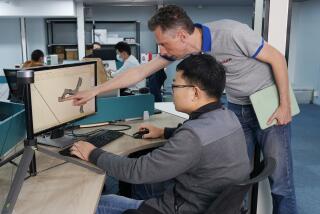High yuan lowers boom
SHANGHAI â Any day now, Chinaâs rapidly appreciating currency will break the key barrier of seven yuan to the dollar. Los Angeles-based Wessco International is dreading it.
Wessco makes toiletry kits, stationery, bags and beverage containers in China and sells them to airliners and hotels around the world. The companyâs sales come in dollars, and it pays Chinese suppliers, office rent and staff here in yuan. For years when the greenback was strong, such outsourcing kept costs low and profits up.
But last year, the Chinese currency rose nearly 7% against the dollar, and it gained an additional 4% in the first quarter.
âIt means a lot of pain,â said Petros Sakkis, Wesscoâs manager in Shanghai.
The yuanâs rapid rise comes at a critical time for manufacturers in China, many of which are struggling with new labor regulations, soaring costs for workers and raw materials, the elimination of export tax rebates and tougher product-safety scrutiny.
In the past, foreign firms could cover increasing costs by squeezing their Chinese suppliers. But with the rise in the yuan and other costs, Sakkis says, thatâs tough to do today. âThe rules of the game have changed.â
The American Chamber of Commerce in Shanghai said 17% of companies surveyed recently planned to move some operations out of China. The study, by the consulting firm Booz Allen Hamilton, cited the appreciation of the yuan as a primary factor.
Recent reports indicate that thousands of factories in southeast Guangdong province, many of them working for U.S. businesses, have closed or moved elsewhere. Meanwhile, some Chinese businesses are refusing payments in dollars; others are breaking contracts saying they canât meet the terms because of the high yuan.
âIf youâre an export business [in China], your life stinks right now,â said Erik Bethel, managing director of ChinaVest, an investment and advisory firm with offices in China and San Francisco.
Itâs been easier for U.S. businesses in China that serve Chinese customers. KFC and Starbucks, whose outlets dot Chinese cities, take in yuan at their cash registers. Foreign companies that are paid in yuan also have an advantage when buying certain commodities, such as rubber, that are priced in dollars.
But many export businesses, particularly those involved in lower-value, labor-intensive goods, are turning to Vietnam. Although its infrastructure isnât nearly as well developed, Vietnam has Asiaâs second-fastest-growing economy after China, with a large supply of cheap labor and favorable government policies reminiscent of Chinaâs earlier days.
Although there are few cases of U.S. companies closing China operations outright, âfirms are expanding into Vietnam instead of increasing investment in China,â said Walter Blocker, past chairman of the American Chamber of Commerce in Vietnam. These include multinational corporations such as Emerson Electric, Intel and Compaq, as well as smaller companies that produce items such as furniture, shoes, plastic bags, pipes and tubing, he and other Americans based in Vietnam said.
The shift to Vietnam and elsewhere in Asia could be accelerated by the movement of the yuan -- although just how fast Chinaâs government will allow it to appreciate is unknown. On the high end, Stephen Green, Standard Chartered Bankâs economist in Shanghai, predicts the Chinese currency will climb 15% against the dollar this year. That would bring the yuan to 6.2 to the dollar.
Before July 2005, the yuan had been set at 8.28 to the dollar for more than a decade. But Washington has been pressing China for years to allow its currency to float freely, arguing that the exchange rate kept Chinese-made goods artificially cheap and exacerbated the trade deficit with the U.S.
For two years, China has let the yuan slowly rise and now controls the daily exchange rate within a narrow 0.5% band.
In 2006, the yuan rose just 3.24% against the dollar. But since the second half of last year, the appreciation has accelerated amid a sharply falling dollar and surging inflation in China. Chinese policymakers figured a stronger yuan would boost imports and curb excess exports, thus slowing the growth of Chinaâs trade surplus and the flood of dollars into China that has pushed up inflation.
So far, though, the yuanâs sharp rise hasnât staunched the massive inflows of cash. In fact, Chinaâs foreign reserves, the largest in the world, have ballooned to $1.65 trillion this year, with about $60 billion added in January and in February -- up from a monthly average of about $40 billion in 2007.
With the yuan appreciating quickly, speculators are continuing to pour money into China, says Michael Pettis, who teaches finance at Peking University. Nor is there clear evidence, he says, that the stronger yuan is reducing Chinaâs trade surplus, even though lower demand for goods from the U.S. appears to have slowed Chinaâs export growth recently.
Before the recent gains in the yuan, some Americans had argued that Chinaâs currency was undervalued by as much as 30%. Treasury Secretary Henry M. Paulson Jr., in Beijing last week, said he was pleased with the recent trend but continued to urge China to let the market determine the yuanâs value.
Others, like Pettis, have argued for a large, one-time revaluation, to give Beijing more control of its economy. But analysts say both strategies may be too risky from Beijingâs perspective.
Chinese officials donât want the yuan to rise too fast and hurt exporters to the point where they lay off workers and drive up unemployment, jeopardizing social stability.
Gong Pinzhong, chairman of Huahong Group, a maker and exporter of photo frames in Yiwu, a trading hub about 200 miles south of Shanghai, reckons that he has lost at least 25% of sales because of the yuanâs appreciation. A year ago, he had 2,800 workers. Thatâs fallen to 2,200, and Gong says he plans to cut another 400 jobs in coming months.
âWe are not expecting to earn money this year, at least not the first half,â he said.
Although the stronger yuan makes U.S.-made goods cheaper for customers in China, Zhang Renren, manager of a U.S.-based wood exporter, said that hadnât translated into a noticeable pickup in orders from China. Thatâs partly because Chinaâs growth is slowing in sectors such as furniture, said Zhang, who asked that his company not be identified as he wasnât authorized to comment. Meantime, he said, his costs of operating an office in Shanghai have soared.
Wesscoâs Sakkis also finds himself in a tough spot, but he sees some solutions. He says Wessco is pushing to build sales in China, which would bring more payments in Chinese currency.
Wessco also hopes to move up the value chain and take advantage of Chinaâs growing pool of skilled and creative talent -- still cheap by Western standards. Two months ago, Sakkis said Wessco opened a design office in Shanghai with a staff of 10.
With the yuan and other costs rising, he said, China as a production base for low-value goods is yesterdayâs news. âWeâre shifting how we look at China,â he said.
--
More to Read
Inside the business of entertainment
The Wide Shot brings you news, analysis and insights on everything from streaming wars to production â and what it all means for the future.
You may occasionally receive promotional content from the Los Angeles Times.









